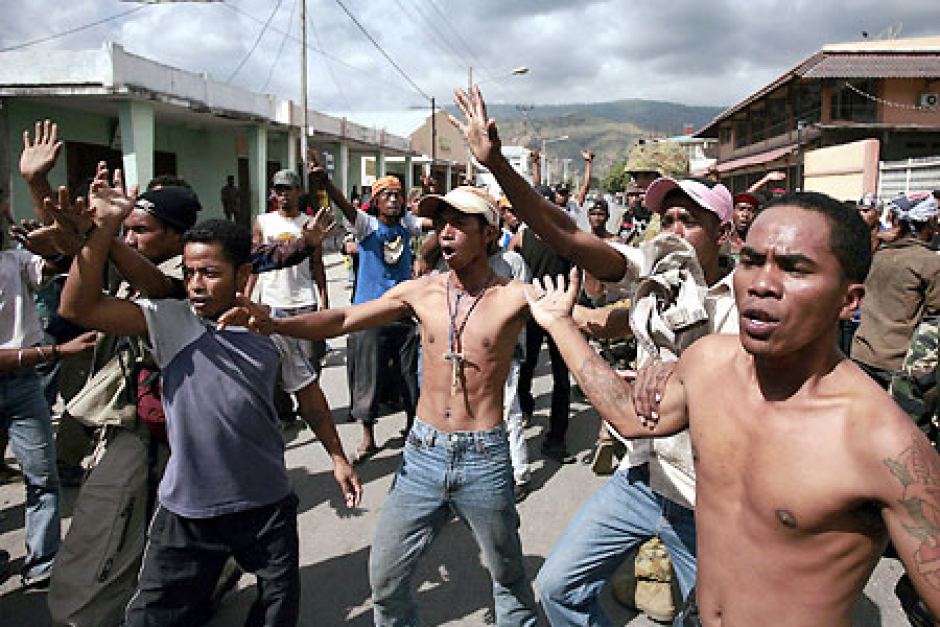East Timor Genocide: The Dark Days of Paradise
What is the East Timor genocide? This article attempts to explain what happened in Timor Leste between 1975 and 1999.
“Animals fight, but do not make war. Man is the only primate who plans extermination within his own kind and executes it enthusiastically and in large dimensions”
Hans Magnus
Indonesia occupied the territory of the present state of Republica Democratica de Timor-Leste from December 1975 to October 1999.
After centuries of Portuguese colonial rule in the eastern part of the island of Timor, a coup d’état in Portugal in 1974 led to decolonization among its ex-colonies, creating instability in the territory and leaving its future uncertain.
After a small-scale civil war, FRETILIN, pro-independence, claims victory in the capital Dili and declares independent Timor-Leste on November 28, 1975.
Claiming aid requested by East Timorese leaders, Indonesian military forces invaded the eastern part of the island on December 7, 1975, and destroyed the armed resistance to the occupation.
Following a controversial “People’s Assembly”, which many said was not a true act of self-determination, Indonesia declared the territory as a province of Indonesia.
For twenty-five years the population of East Timor has been subjected to extrajudicial executions, torture, and famine.
East Timor genocide
It is estimated that the occupation cost more than 200,000 deaths in the territory, for a population of fewer than one million people.
On June 20, 1988, ten East Timorese students in Indonesia proclaimed the Timor-Leste Student General Political Uprising, led by Fernando La Sama de Araújo.
This moment, together with the creation of the RENETIL organization, reinforced and developed political awareness, giving external visibility to Timorese struggle, self-determination, and independence.
The Santa Cruz Massacre in 1991 caused worldwide outrage, and reports of other such crimes were numerous.
The resistance to Indonesian domination remained strong; in 1996, the Nobel Peace Prize was awarded to two great men of East Timor, Bishop of the Catholic Church D.Carlos Filipe Ximenes Belo and the representative of FRETILIN abroad, José Ramos-Horta, for their ongoing efforts to end with the occupation peacefully.
A 1999 vote to determine the future of the territory resulted in an overwhelming majority in favor of independence, and in 2002, Timor-Leste became an independent nation.
Immediately after the invasion, the UN General Assembly and the Security Council passed resolutions condemning Indonesia’s actions and calling for immediate withdrawal.

Constant Lack of International Support to Timor-Leste
The governments of the United States, Australia, and the United Kingdom have been supporting Indonesia during the occupation.
US President Gerald Ford and Secretary of State Henry Kissinger met with Indonesian President Suharto on the eve of the invasion and gave his approval for the invasion (1).
Australia and Indonesia were the only nations in the world to recognize Timor-Leste as a province of Indonesia, and soon afterward negotiations began to divide the resources found in the surrounding maritime area known as the Timor Gap.
Other countries, including Japan, Canada, and Malaysia, also supported the Indonesian government.
The invasion and repression of the East Timor independence movement, however, have done a great deal of damage to Indonesia’s reputation and international credibility.
Following the 1999 independence vote, paramilitary groups working with the Indonesian military undertook a last wave of violence during which most of the country’s infrastructure was destroyed.
After Indonesian forces left Timor-Leste, the United Nations Transitional Administration in East Timor administered the territory for two years, establishing a “Serious Crimes Unit” to investigate and prosecute crimes (East Timor genocide) committed during the year 1999.
Reborn from the ashes of his black history, East Timor is now an independent country that has not forgotten (even in East Timor flag we can see references to this dark days) but has forgiven for that has happened to it.
Timorese people are always with open arms and very big smiles, waiting for you.
You will see is worth it… Visit East Timor.
Latest Posts
- Charles Sturt University Student Gains Valuable Insights from Timor-Leste Agriculture Study Tour
- Timor-Leste Acts Against Potential Human Trafficking: Prevents Youths Traveling to Cambodia
- Timor-Leste President Advocates for India as Permanent Member of Reformed UN Security Council
- Over 100 Displaced by Heavy Rains in Dili, Timor Leste
- Timor-Leste and WFP Join Forces to Support Pregnant and Lactating Women

Stay connected